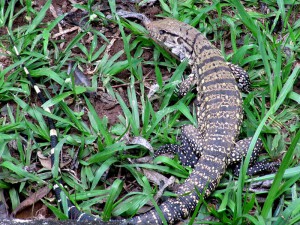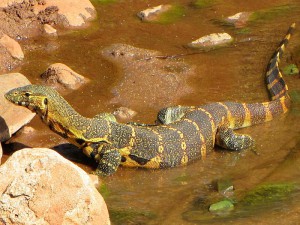You may have seen it on the news or read it in the paper…one of our newest invasive species threats is the black-and-white Argentine tegu. The tegu is a large lizard, similar in appearance to an iguana or the Nile monitor lizard. The iguana, Nile monitor, and these tegu lizards are non-native, invasive species posing a serious threat to our native wildlife.


The tegu, which first arrived in the United States in the early 2000s, has now established populations in Hillsborough and Miami-Dade counties. Escaped or released pets allowed their establishment in the natural environment. Young tegus posses a greenish head which is attractive to potential pet owners, but this green coloration fades as they grow larger and stronger. Tegus can grow up to four to five feet long and their head and neck are described as being thicker than that of monitor lizards. Their tongues are reddish pink in color and are forked at the end. Their backs are lined with horizontal dark bands intermixed with lighter-colored bands with dark speckles. There is also a dark line extending from the eye.
Tegus have been found to feed upon the eggs of ground-nesting birds, turtles and even alligators, posing a threat to many of our threatened and endangered species. They will also feed upon many other items including plant material and carrion or dead animals. Their diverse diet makes them opportunistic feeders, eating much of what is available to them as they can find it.
The black-and-white tegus live in dry, upland areas with sandy soil, but have also inhabited other natural, urban and agricultural areas. The tegus may dig their own burrow or take over the burrows of other animals such as our native and threatened gopher tortoise. These burrows are utilized by the lizards during the late fall and winter months where they remain underground. The tegus can live to be 15 to 20 years old and lay eggs twice a year with anywhere between five to 30 eggs per clutch. Their ability to lay this many eggs and hibernate underground give them great advantages to surviving in Florida.
 If you see this lizard out in the wild, report it immediately by calling 1-888-IveGot1 (1-888-483-4681). It is an easy task to enter this number into your phone should you come across one as you travel around Pinellas County. If you see a tegu, but don’t happen to have your phone on you, you can also report your sighting online at http://IveGot1.org. Photos are also very helpful in confirming your sighting. You can find out more and receive free online training on how to report sightings through the Introduced Reptile Early Detection & Documentation (REDDy) at http://ufwildlife.ifas.ufl.edu/reddy.shtml.
If you see this lizard out in the wild, report it immediately by calling 1-888-IveGot1 (1-888-483-4681). It is an easy task to enter this number into your phone should you come across one as you travel around Pinellas County. If you see a tegu, but don’t happen to have your phone on you, you can also report your sighting online at http://IveGot1.org. Photos are also very helpful in confirming your sighting. You can find out more and receive free online training on how to report sightings through the Introduced Reptile Early Detection & Documentation (REDDy) at http://ufwildlife.ifas.ufl.edu/reddy.shtml.
 0
0
